Why You Should Add Alum Salt to Your Water
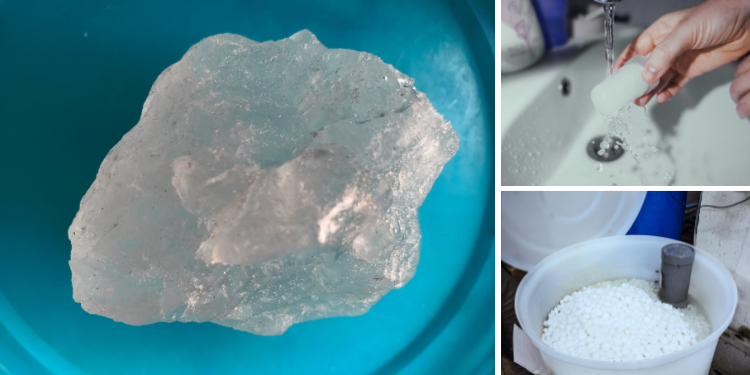
Alum may just become your favorite spice cabinet survival tool once you realize how effective it is at water purification. Alum salt, also known as potassium alum (potash alum) or aluminum sulfate, has been used for centuries not only for its keen preservation properties but also for its prowess at purifying water.
If you are a canner, you’re already quite familiar with how helpful alum is during the food preservation process. By adding alum to pickling brine it helps maintain the crispness and freshness of fruits and vegetables. The many wonders of alum do not end there, folks. Alum may help relieve symptoms of canker sores and promote oral hygiene. By dissolving alum in water and using it as a mouth rinse, it can help reduce inflammation and soothe oral irritations.
Alum salt is a powerful water purification agent that has been used for centuries to treat water and improve its quality. When added to water, alum binds to the particles and forms larger clumps that can easily be filtered out. This can help improve both the taste and clarity of drinking water while making it safer for consumption. Additionally, alum is effective in removing excess phosphates and other contaminants that can contribute to water pollution. This is why aluminum sulfate is frequently used in improving the quality of lake water.
The Science Behind Alum Salt
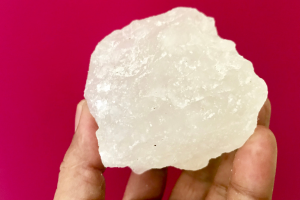 To understand how alum salt works as a water purification agent, it’s important to delve into its chemical composition.
To understand how alum salt works as a water purification agent, it’s important to delve into its chemical composition.
The chemical composition of alum salt, or potassium aluminum sulfate, is integral to the water purification process.
Alum salt is a hydrated sulfate salt, which means it contains sulfate ions (SO4) and water molecules (H2O) in its crystal structure.
The crystal structure of alum salt consists of potassium ions (K+) surrounded by sulfate ions (SO4) and water molecules. The presence of the sulfate ions allows alum salt to form strong bonds with impurities in water, while the water molecules contribute to the solubility and stability of the compound.
Alum salt, or potassium aluminum sulfate, has the chemical formula KAl(SO4)2·12H2O. It is a hydrated sulfate salt that consists of potassium, aluminum, sulfur, and oxygen atoms. Alum salt is usually sold as a fine white powder or in crystal form.
The production process of alum salt involves adding potassium sulfate to a concentrated solution of aluminum sulfate. The resulting reaction leads to the formation of potassium aluminum sulfate crystals. These crystals are then crushed into a powder or shaped into larger crystals for various applications.
How Alum Salt Works in Water Purification
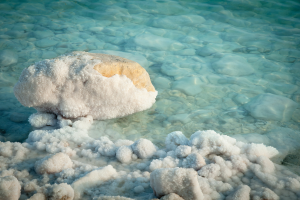 Alum salt works as a water purification agent through a process called coagulation. When alum salt is added to water, it releases positively charged aluminum ions (Al3+). These ions attract and bind with negatively charged impurities, such as suspended particles, organic matter, and bacteria, in the water.
Alum salt works as a water purification agent through a process called coagulation. When alum salt is added to water, it releases positively charged aluminum ions (Al3+). These ions attract and bind with negatively charged impurities, such as suspended particles, organic matter, and bacteria, in the water.
This process causes the impurities to clump together and form larger particles, a process known as flocculation. These larger particles then settle to the bottom of the water container or can be easily filtered out, resulting in clearer and purer water. There is also this DIY off-grid water filter the Amish people use and it proved indispensable for hundreds of years.
Benefits of Adding Alum Salt to Your Water
Adding alum salt to your water offers several benefits for both your health and the quality of your water. Here are the key benefits of using alum salt for water treatment:
- Alum salt helps remove suspended particles, sediments, and turbidity from water, resulting in clearer and visually appealing water.
- The coagulation properties of alum salt can effectively remove organic matter, bacteria, and other impurities from water, improving its overall purity.
- Alum salt can help reduce the presence of harmful bacteria and microorganisms in water, making it safer for drinking and other uses.
Health Benefits Associated with Alum-Treated Water
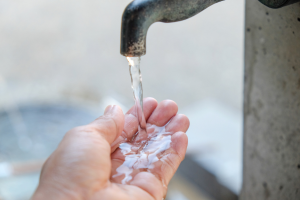 In addition to improving water clarity and purity, alum-treated water offers several health benefits.
In addition to improving water clarity and purity, alum-treated water offers several health benefits.
Here are some health benefits associated with alum-treated water:
- Reduced risk of waterborne diseases: Alum-treated water has a lower presence of harmful bacteria and microorganisms, reducing the risk of waterborne diseases such as cholera and Typhoid Fever. Those seemingly deadly illnesses of yesteryear could quickly reappear is during a long-term SHTF.
- Improved digestive health: Drinking water treated with alum can help maintain a healthy digestive system by removing impurities and potential contaminants.
- Enhanced hydration: With clearer and purer water, drinking alum-treated water can improve hydration levels and support overall bodily functions.
Related: 50 Survival Uses For Salt
It’s important to note that alum-treated water is safe for consumption and poses no significant health risks. The small dosage of alum used in water treatment does not introduce harmful levels of aluminum or potassium sulfate into the water.
Historical Uses of Alum Salt
Throughout history, alum salt has played a significant role in various applications, including water treatment. Its unique properties and effectiveness in purifying water have been recognized by ancient civilizations and medieval medicine. This is a glimpse into the historical uses of alum salt:
- Ancient civilizations, such as the Egyptians and Romans, used alum salt as an effective water purification agent.
- There is also a traditional way of making salt from plants. You can find all about the process here.
- Alum salt was used in medieval medicine as an astringent and antiseptic, with applications ranging from wound healing to oral care. It was applied topically for wound healing, to stop bleeding, and as a treatment for various skin conditions.
Practical Guide to Using Alum Salt
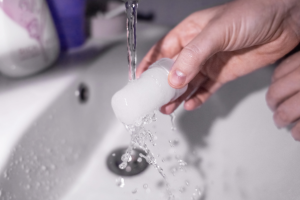 Determine the water volume: measure the volume of water you need to treat, whether it’s a large container or a specific amount for drinking.
Determine the water volume: measure the volume of water you need to treat, whether it’s a large container or a specific amount for drinking.- Calculate the dosage: refer to dosage guidelines based on the water volume. Typically, the recommended dosage is 1-3 grams of alum salt per liter of water.
- Dissolve alum salt: dissolve the calculated amount of alum salt in a small amount of water, ensuring it is fully dissolved before adding it to the water to be treated.
- Add alum salt to water: pour the dissolved alum salt solution into the water you want to treat, stirring gently to ensure thorough mixing.
- Allow settling or filtration: let the treated water settle for a period of time to allow the impurities to settle to the bottom. Alternatively, you can use a filtration system to remove the larger particles.
- Use treated water: once the settling or filtration process is complete, you can use the treated water for various purposes, including drinking, cooking, and hygiene.
How Much Alum to Use for Water Treatment
The dosage of alum salt for water treatment depends on the volume of water you need to treat. Here’s a text table providing dosage guidelines based on water volume:
| Water Volume | Alum Salt Dosage |
| 1 liter | 1-3 grams |
| 1 gallon | 4-12 grams |
| 10 gallons | 40-120 grams |
| 100 gallons | 400-1200 grams |
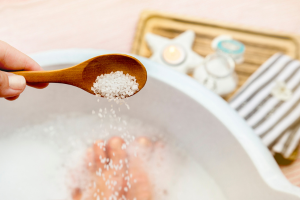 These dosage guidelines are approximate values and may vary depending on the specific water quality and impurity levels. It is recommended to start with a lower dosage and adjust as needed based on the desired water clarity and purity. Always refer to the manufacturer’s instructions for precise dosage recommendations for the specific alum salt product you are using.
These dosage guidelines are approximate values and may vary depending on the specific water quality and impurity levels. It is recommended to start with a lower dosage and adjust as needed based on the desired water clarity and purity. Always refer to the manufacturer’s instructions for precise dosage recommendations for the specific alum salt product you are using.
Alum Safety Considerations and Best Practices
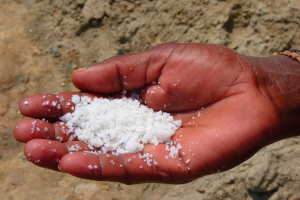 While alum salt is generally safe to use for water treatment, it’s important to observe safety considerations and best practices to minimize any potential risks.
While alum salt is generally safe to use for water treatment, it’s important to observe safety considerations and best practices to minimize any potential risks.
Here are some key safety considerations when handling alum salt:
- Avoid inhalation: When working with alum salt in powder form, avoid inhaling the powder to prevent respiratory irritation. Wear a protective mask or work in a well-ventilated area.
- Avoid contact with eyes and skin: Alum salt may cause irritation if it comes into contact with the eyes or skin. If contact occurs, rinse thoroughly with water and seek medical attention if necessary.
- Store in a dry place: Keep alum salt in a dry, cool place away from moisture to prevent clumping or degradation. Ensure the container is tightly sealed to maintain its efficacy.
- Keep out of reach of children: Store alum salt out of the reach of children to prevent accidental ingestion or misuse.
- Overdosing: Using excessive amounts of alum salt can lead to over flocculation, resulting in water that is too clear and may lack essential minerals. Follow dosage guidelines and avoid using more than the recommended amount.
- Allergic reactions: Some individuals may be allergic to alum salt and may experience skin irritation or other allergic reactions. If you have a known allergy to alum salt or experience any adverse reactions, discontinue use and seek medical advice..
Alum Salt vs. Chlorination
Alum salt and chlorination are both effective in water purification, but alum salt is more commonly used for clarification and removal of suspended particles, while chlorination primarily targets microorganisms.
The Alum salt is primarily used for clarification and removal of suspended particles, sediments, and turbidity in water. It can improve water clarity and remove organic matter but is less effective against microorganisms. Alum salt is cost-effective, easy to use, and suitable for larger volumes of water. Speaking of large volumes, this is how you can make a pressurized rainwater harvesting and purification system in your own backyard.
Chlorination is a widely used method for disinfection and killing harmful microorganisms in water. It effectively eliminates bacteria, viruses, and pathogens but may not effectively remove suspended particles or improve water clarity. Chlorination requires careful dosage control and may have a residual taste and odor in treated water.
Alum vs. Modern Water Filters
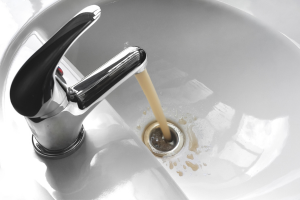 Alum salt provides a cost-effective and efficient solution for water treatment, especially for larger volumes. Modern filters, on the other hand, offer convenience and versatility for smaller-scale water treatment.
Alum salt provides a cost-effective and efficient solution for water treatment, especially for larger volumes. Modern filters, on the other hand, offer convenience and versatility for smaller-scale water treatment.
The Alum salt is highly efficient in clarifying water, removing suspended particles, sediments, and turbidity. It is cost-effective, easy to use, and suitable for larger volumes of water. However, alum salt may not effectively remove microorganisms and may require additional treatment methods for complete disinfection.
Related: Never Trust This Water Source Again
Modern water filters, such as activated carbon filters or reverse osmosis systems, offer greater versatility and precision in water treatment. They can effectively remove suspended particles, microorganisms, and even specific contaminants or chemicals. Modern filters provide a higher level of water purification but may be more expensive and require regular maintenance. They take up far more space to stockpile than spice bottles filled with alum. That’s why you should try a device that helps you make water out of thin air. I have one at home and I was amazed of how much water it produces.
Environmental Impact of Using Alum Salt
Alum salt usage can have some impact on aquatic life and ecosystems, primarily due to the release of aluminum ions in water. High concentrations of aluminum ions can be toxic to certain species of aquatic organisms.
To minimize the environmental impact of alum salt usage, it is important to follow sustainable practices. This includes using alum salt in appropriate dosages, and adhering to local regulations for wastewater management.
High concentrations of aluminum ions in water can be toxic to certain species of aquatic organisms, including fish and invertebrates. Aluminum ions can disrupt the balance of ions and nutrients, affecting the health and reproduction of aquatic life.
Final Thoughts
Alum salt offers a natural and effective solution for water purification with a rich historical background. By understanding its chemical composition and benefits, you can enhance water clarity and promote health. Following safety guidelines ensures optimal usage while considering its environmental impact.
You may also like:
Preppers’ Promised Land (Just Found)
What Happens If You Pour Salt Into a Cabbage (Video)
How to Grow Medicinal Herbs On Your Windowsill
5 Foods That Disappear First In A Crisis
Items That Will Get You on FEMA’s Radar
Read the full article here







